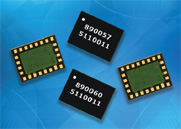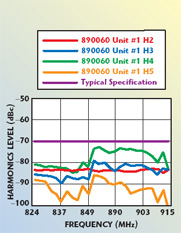
A January 2006 survey from the GSA (Global mobile Suppliers Association) confirmed strong growth and market acceptance of WCDMA as the leading global 3G technology. The number of 3G/WCDMA networks delivering commercial services was then pegged at 100 in 42 countries, an increase of 22 networks during 2005. A wide variety of WCDMA/HSDPA terminal devices have been announced in the market, 186 models from 26 suppliers, with 70 models launched just in the last six months. The survey also identifies 57 operators now serving customers, or in the process of deploying combined WCDMA and EDGE networks.

Initial growth has been primarily focused on single-band WCDMA (IMT/UMTS) 2100 plus GSM/EDGE, targeting the European and Asian marketplaces. Following in short order, carriers will release dual-band WCDMA-850 and WCDMA-1900 networks that will target the US.
To ensure service continuity, both WCDMA and GSM/EDGE must be incorporated into the handset terminal. Multi-mode/multi-band integrations into a single terminal will create both opportunities and challenges for the handset designer.
With the success of Motorola’s Razr“ handset in 2005 (more than 12 million handsets sold so far), a model for the future has been established: ultra-thin, feature-rich, lightweight and with no external antenna. The Razr has set the bar higher than ever before, challenging module/component suppliers to offer the handset designer highly integrated products that provide the smallest possible footprint in the thinnest package available. Size has therefore taken center stage, and as the market had demonstrated with all things wireless so far, smaller is bigger when it comes to sales and satisfied customers.

The integration and efficiency requirements of the WCDMA RF front-end require key technologies, including the ability to optimize components to transceiver and baseband while being as ‘miserly’ with power conservation as possible. All this has to come in ever-shrinking package form factors and with platform concepts in mind, design cycle time (and reducing it) comes near the top of every module shopper’s wish list.
Addressing the technical challenges of the new multi-mode WCDMA handset, highly integrated WCDMA front-end modules (FEM) combine the GSM SAW Rx filters, a multi-mode switch and transmit harmonic filters into an ultra-small footprint with a very low profile (5.4 × 4.0 × 1.1 mm3).
A key component of the WCDMA FEM is front-end switching technology, which in earlier generation GSM wireless phones has historically been dominated by PIN diode applications. PIN diodes have demonstrated longevity, providing handset designers with a simple solution at the lowest possible cost. However, PIN diodes have now reached their limitations and will struggle to provide competitive switching solutions that can meet the technical demands of the WCDMA (3G) handset (size and current consumption requirements, for example).
PIN diodes must inevitably give way to new switching technologies. However, the new technology must meet the demanding requirements of the 3GPP technical specification if they are going to take a leadership role and displace PIN diodes. The primary challenges in meeting the 3GPP specification in this area that demand attention include:

- WCDMA linearity (out-of-band blocking)
- GSM linearity (harmonics)
- Insertion loss and isolation performance.
WCDMA Linearity
(Out-of-band Blocking)
A switch must address the out-of-band blocking requirements in order to address WCDMA linearity needs. Designers critically examine the various discrete components or the antenna switch module (ASM), or the front-end module (FEM) located between the antenna and the transceiver/baseband when looking at linearity issues. They are concerned primarily with out-of-band (third-order) linearity performance. The third or higher out-of-band interferer arises to a mixing effect of the transmitted WCDMA signal with an external blocker signal (see Figure 1). The mixing effect in this case is producing an interfering signal in the receive band of the relative transmitted channel. This in turn creates distortions in the receiver channel passband (intermodulation products are created when two or more frequencies mix in nonlinear devices).
The third or higher intermodulation measurement is used to define the receiver faculty to treat the desired signal even in the presence of any unwanted signals in its assigned frequency range.
WCDMA receiver RF tests use coded bit-error rate (BER) as the performance metric to assess specification compliance. To pass the receiver tests, a coded BER of < 0.1 percent is required under a range of test conditions designed to stress sensitivity, linearity and selectivity of the receiver. The out-of-band requirement is defined only implicitly by the need of the frequency-division duplexing (FDD) receiver to pass out-of-band blocking de-sense tests in the presence of a large transmit leakage signal at the antenna. From the WCDMA specifications, four blocking regions exist that can produce in-channel products when mixed with the transmitter leakage signal.
Based on industry standards and the authors’ own calculations, it has been determined that the out-of-band intermodulation product produced by the switch should not exceed –103 dBm with the conditions specified in Table 1. This –103 dBm level does not take away from any of the 24 possible exceptions at the final system level test allowed in the 3GPP specification. The WCDMA port is also terminated with a high impedance duplexer and the blocker signal will be presented to the antenna at an unknown phase. Therefore, the handset designer must insure that the FEM meets the performance in Table 1 across all possible phases. Switch IM3 linearity performance is extremely phase dependent, as seen in Figure 2.

Phase must be considered when determining the linearity of the multi-mode switch because this is the only certain method to meet the 3GPP out-of-band blocking requirements. The plot demonstrates the possible variability of IM3 performance over phase. It is shown that the FEM is meeting the previously stated requirement. Another important point is to identify the differences between a two-tone IM3/IIP3 test as compared to a standard single-tone IIP3 test condition. The switch IP3 performance is used to determine the in-band linearity, but the IP3 performance should not be used to determine whether the antenna switch meets the selectivity requirement or provides adequate blocking characteristics. The IP3 performance can only be used for reference purposes and does not correlate into IM3 selectivity. Therefore, it is highly recommended to quantify the out-of-band linearity of a switch by measuring the exact modulation product found in the Rx-band (IM3) or by the IIP3 through a two-tone measurement. A switch that meets the out-of-band linearity standard will inherently meet the in-band linearity requirements.
GSM Linearity (Harmonics)
Just as the multi-mode WCDMA phone must conform to the 3GPP specification for WCDMA, its GSM linearity (harmonics) must continue to meet ETSI technical standards. While advanced switching technologies struggled in years past with GSM harmonic performance, many technology advancements have been made to overcome previous challenges. As seen in Figures 3 and 4, the TriQuint FEM has overcome and meets all GSM harmonic requirements.

Insertion Loss and Isolation Performance
Finally, while WCDMA and GSM linearity are of utmost importance, one cannot overlook the need for lower insertion loss, increased band-to-band isolation, 2fo, 3fo Tx harmonic filtering and Rx attenuation. While many trade-offs are needed to meet the WCDMA 3GPP specification, insertion loss cannot be compromised. 3G phones will include as many as twelve different frequency bands, requiring improved insertion loss and isolation. Continued integration of the baseband and transceiver requires improved Rx attenuation performance from the SAW filters as well. New switch, Rx SAW and Tx filtering technology have allowed FEMs to meet the linearity requirements stated above while providing competitive RF performance, as seen in Table 2.
All FEM modules must include switch technology capable of meeting WCDMA and GSM/EDGE linearity performance while maintaining the lowest insertion loss and highest isolation performance. Integration of the four GSM Rx SAW filters is critical to achieving the highest level of integration and providing the smallest footprint while targeting the lowest height profile possible. Highly integrated FEMs can only be achieved through the advancements of SAW filter and module packaging technology.

Meeting the demands of WCDMA customers is an opportunity that will continue to challenge incumbent RF suppliers. To that end, TriQuint Semiconductor has a wide range of modules that address the specific needs of WCDMA and hybrid ‘WEDGE’ handsets that are highly integrated, compact and designed around the stringent requirements of the new 3G standard.
Key components for any supplier seeking to satisfy the needs of WCDMA handset manufacturers should include:
- A single-band WCDMA FEM plus quad-band EDGE GSM-850/
900/1800/1900 - A dual-band WCDMA FEM plus quad-band EDGE GSM-850/900/
1800/1900 - Transmit modules that include a WCDMA multi-mode switch, Tx harmonic filtering and the quad-band GSM EDGE PA
- WCDMA PA+duplexer modules that integrate the WCDMA PA with the WCDMA duplexers — PA+duplexer modules offer another level of integration that optimize the performance of the PA together with the duplexer.
The new WCDMA front-end modules are part of a larger portfolio of products optimized for the transceiver to baseband that are designed for future 3G slim-line, compact multi-mode/multi-band mobile devices. Additional information may be obtained via e-mail at bleonard@tqs.com.
TriQuint Semiconductor,
Orlando, FL (407) 886 8860,
www.triquint.com.
